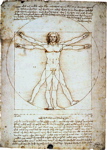Math Brain Teaser: Concentric Shapes or The Unkindest Cut of All, Part 2 of 2
If you missed Part 1, also written by puzzle master Wes Carroll, you can start there and then come back here to Part 2.
Concentric Shapes:
The Unkindest Cut of All, Part 2 of 2
Difficulty: HARDER
Type: MATH (Spatial)

Question:
Imagine a square within a circle within a square. The circle just grazes each square at exactly four points. Find the ratio of the area of the larger square to the smaller.
In this puzzle you are working out many of the same skills as in Part I: spatial visualization (occipital lobes), memory (temporal lobes), logic (frontal lobes), planning (frontal lobes), and hypothesis generation (frontal lobes).
Solution:
Two to one.
Explanation:
Draw the smaller square’s diagonal to see that the the smaller square’s diagonal is the diameter of the circle. Divide the larger square into two equal rectangular halves to see that the larger square’s side is also the diameter of the circle. This means that the smaller square’s diagonal equals the larger square’s side. (Or, if you prefer, simply rotate the inner square by 45 degrees.) As we’ve seen in the earlier puzzle “The Unkindest Cut Of All,” the area of the smaller square is half that of the larger, making the ratio two to one.
More brain teaser games:



I mis-read the instructions to be the opposite: an outer circle, a square inside that and another circle inside the square, and calc the area difference between the *circles*. Perhaps I looked at the picture instead of read the instructions!
Anyway, I solved it with trig (draw a right triangle with one point in the center, another to a corner of the square and another to a near side of the square). The area of each circle can be derived from the length of the shorter side.
Interestingly, it comes out to the same answer: the outer circle is twice the area of the smaller one!
I think you created a more difficult brain teaser! Nice solution. Now we just need to strengthen those reading attention skills! ;-) (sorry if the picture was misleading — I just like the picture and thought it went with the theme, if not the specifics)
THIS WAS FUN (I GOT THEM ALL OF COURSE EXCEPT THE VEGETABLES.
FRUIT OF A PINE TREE
(SEEDS ON OUTSIDE)
I did it by saying that the outer square’s area is x^2. The internal square’s diagonal length must be x, so its perpendicular length must be the square root of x^2 / 2 (Pythagorus). Squaring that undoes the square root, so you get x^2 compared to x^2 / 2. Factoring down the x^2 to 1, we get 1/0.5.. or 2/1.
Its easy if you realize that the radius of the circle is both half the diagonal of the smaller square and half the side value of the larger square.
quite easy, i like those kind of problems
I arrived at this conclusion through “grazing both squares in exactly 4 points” — corners of the smaller one, and the ‘centers’ of walls of the bigger one.
Primarily through “spatial reasoning”, rotated the inner square, and arrived at a point stated in the previous puzzle.
10 seconds. Once again, change it to “Easy” (esp. if someone solved, or at least read, the previous puzzle).